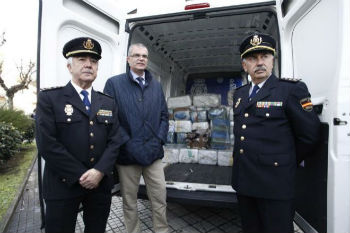Authorities in Spain seized over one ton of cocaine from a Colombian drug trafficking network and arrested dozens of its members, a potential sign that the surge in Colombia’s cocaine production is altering trafficking patterns in yet another part of the world.
Spain’s National Police captured 24 members of a Colombian drug trafficking group that was seeking to establish a new maritime route into Spain, reported EFE. The operation, which was carried out last weekend, also reportedly netted a seizure of 2,400 kilograms of cocaine.
“It is one of the most important operations against cocaine trafficking that has been carried out in Spain in recent years, not just because of the large quantity of drugs, but because of the number of people detained, some of whom are very important in international cocaine trafficking,” said Ricardo Toro, the Director of the Special Response Group for Organized Crime.
“If [the authorities] hadn’t triumphed with their operation, they probably would have installed themselves here, in Galicia and in other parts of Spain,” Toro continued.
The investigation began in June 2016, according to EFE, when Spanish authorities identified a known Colombian drug trafficker who was attempting to open a permanent “oficina,” or office, in Madrid.
More recently, the Spanish Civil Guard arrested 12 alleged members of a drug trafficking ring in Las Palmas de Gran Canaria, a city in one of the Canary Islands off the northwestern coast of Africa. Most of the suspects are of Colombian, Lithuanian, and Ukrainian nationality, and are allegedly responsible for smuggling close to 400 kilograms of cocaine into Europe, EFE reported separately.
InSight Crime Analysis
The raid of a Colombian drug ring in Spain is not exactly revelatory; the country has long served as the entry point for Colombian traffickers seeking a way into the lucrative European drug market. In 2014, Spanish police told InSight Crime that Colombians had set up between 12 and 20 “oficinas de cobro,” which are criminal structures that are often involved in drug trafficking and money laundering.
Still, the amount of cocaine seized and the number of Colombians involved suggests Spain may be beginning to feel the effects of spiking cocaine production back in Colombia. Both the United Nations and the United States have registered significant increases in coca cultivation in recent years, and US officials recently told El Tiempo they believe there is now more coca being sown in Colombian soil than at any other point in the country’s history.
SEE ALSO: Coverage of Cocaine Production
There are already indications that the huge rise in cocaine production has impacted trafficking patterns in Latin America and consumption habits in the United States. A recent report by the US State Department linked Colombia’s cocaine boom to greater availability and usage of the drug in the United States, something that hasn’t been seen in nearly a decade. Seizures are also on the upswing in Central America and Mexico, as are confiscations of multi-ton cocaine shipments, which had become increasingly rare in recent years.
But with the amount of cocaine now flooding the market, it appears traffickers are willing to take bigger risks by sending larger shipments to more profitable markets like the United States and Europe.

